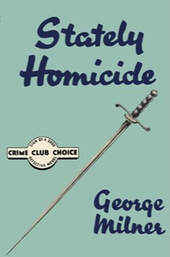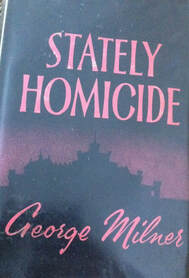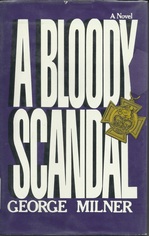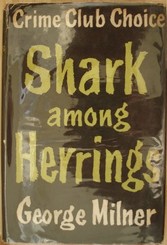
In Stately Homicide, Anglesea is called to Tranby Castle by the Marchioness and asked to discover who was responsible for sending a telegram with deadly mechanical directions to Sir Richard’s racing team at the Barcelona Grand Prix. Before he can solve that mystery, a more immediate tragedy occurs: Lady Tranby is found dead in her bedroom, impaled by a family sword with the phrase Vengeance Is Mine written in lipstick on the wall. The detective believes that the victim’s husband, Henry, and family members Peter, Anne, and Jimmy all know more than they are willing to confess, and it is this knowledge that allows the pressure to build to a climax where another life is very nearly be taken.
For a mystery series editor, the author seems to struggle here with pacing; plotting is on stronger ground and the murder, occurring a third of the way through the story, at least offers a memorable visual tableau. But the plot within the first 60 pages of Stately Homicide meanders more than it should. We are introduced to the characters who will become the murder suspects, but they don’t really achieve definition (or interest) until that crime occurs. Milner’s prose may be humorous and gently satirical, but the book feels padded. I could have done without, for example, a quartet of doggerel verses Anglesea delivers to celebrate his love interest’s toes as she sways barefooted in a hammock. Other narrative digressions are more welcome, as when the author winks at the archetypes found within the mystery fiction genre:
It is a constant wonder to me how private detection survives as a profession. Some faint anomaly, discrepancy or suspicion may lead to the employment of a private detective and – Bang! Within the hour one of the employer’s nearest and dearest has gone to join his Maker in circumstances which are freakish, grotesque, bloody and much-publicised. As the sack of the city follows the admission of a spy, to employ a private detective is to invite sudden death. I was once commissioned to check a clause relating to jewellery in a marriage settlement, and I hadn’t even unfolded the document before the sound of gunfire broke out all over the house. A detective is a catalyst.

Still, it is arguably fair-play, with snippets of overheard dinner conversation, some persistent lawn maintenance, and a reference to “The Duchess of Kingston” enough for Ronald Anglesea to penetrate the family secret. Manor house parties certainly appealed to the author; this book and the next one let Milner’s detective play the outsider, moving among the aristocracy and enjoying his host’s hospitality while he dissects the dysfunction he finds among the many rooms of these stately homes.


 RSS Feed
RSS Feed